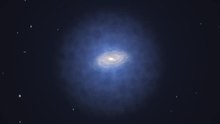Dark matter is an unidentified type of matter distinct from dark energy, baryonic matter (ordinary matter), and neutrinos. The name refers to the fact that it does not emit or interact with electromagnetic radiation, such as light, and is thus invisible to the entire electromagnetic spectrum. Although dark matter has not been directly observed, its existence and properties are inferred from its gravitational effects such as the motions of visible matter, gravitational lensing, its influence on the universe's large-scale structure, on galaxies, and its effects in the cosmic microwave background.
The standard model of cosmology indicates that the total mass–energy of the universe contains 4.9% ordinary matter, 26.8% dark matter and 68.3% dark energy. Thus, dark matter constitutes 84.5% of total mass, while dark energy plus dark matter constitute 95.1% of total mass–energy content. The great majority of ordinary matter in the universe is also unseen, since visible stars and gas inside galaxies and clusters account for less than 10% of the ordinary matter contribution to the mass-energy density of the universe. The most widely accepted hypothesis on the form for dark matter is that it is composed of weakly interacting massive particles (WIMPs) that interact only through gravity and the weak force.
The dark matter hypothesis plays a central role in current modeling of cosmic structure formation and galaxy formation and evolution and on explanations of the anisotropies observed in the cosmic microwave background (CMB). All these lines of evidence suggest that galaxies, galaxy clusters, and the universe as a whole contain far more matter than that which is observable via electromagnetic signals. Many experiments to detect proposed dark matter particles through non-gravitational means are under way; however, no dark matter particle has been conclusively identified.
Although the existence of dark matter is generally accepted by most of the astronomical community, a minority of astronomers, motivated by the lack of conclusive identification of dark matter, argue for various modifications of the standard laws of general relativity, such as MOND, TeVeS, and conformal gravity that attempt to account for the observations without invoking additional matter.
Observational evidence
Much of the evidence comes from the motions of galaxies. Many of these appear to be fairly uniform, so by the virial theorem, the total kinetic energy should be half the galaxies' total gravitational binding energy. Observationally, the total kinetic energy is much greater. In particular, assuming the gravitational mass is due to only visible matter, stars far from the center of galaxies have much higher velocities than predicted by the virial theorem. Galactic rotation curves, which illustrate the velocity of rotation versus the distance from the galactic center, show the "excess" velocity. Dark matter is the most straightforward way of accounting for this discrepancy.
The distribution of dark matter in galaxies required to explain the motion of the observed matter suggests the presence of a roughly spherically symmetric, centrally concentrated halo of dark matter with the visible matter concentrated in a central disc.
Low surface brightness dwarf galaxies are important sources of information for studying dark matter. They have an uncommonly low ratio of visible to dark matter, and have few bright stars at the center that would otherwise impair observations of the rotation curve of outlying stars.
Gravitational lensing observations of galaxy clusters allow direct estimates of the gravitational mass based on its effect on light coming from background galaxies, since large collections of matter (dark or otherwise) gravitationally deflect light. In clusters such as Abell 1689, lensing observations confirm the presence of considerably more mass than is indicated by the clusters' light. In the Bullet Cluster, lensing observations show that much of the lensing mass is separated from the X-ray-emitting baryonic mass. In July 2012, lensing observations were used to identify a "filament" of dark matter between two clusters of galaxies, as cosmological simulations predicted.
In August 2016, astronomers reported that Dragonfly 44, an ultra diffuse galaxy (UDG) with the mass of the Milky Way galaxy, but with nearly no discernable stars or galactic structure, may be made almost entirely of dark matter.



No comments:
Post a Comment